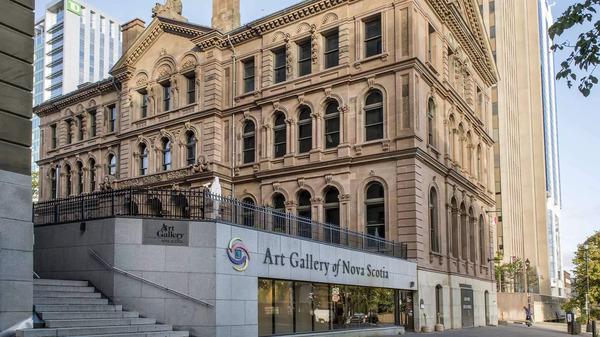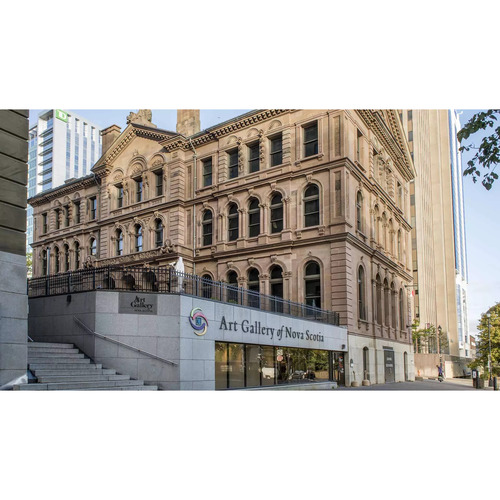
Source: Link
STIRLING (Sterling), DAVID, architect and entrepreneur; b. 6 Dec. 1822 at Galashiels (Borders), Scotland, son of James Stirling, stonemason, and Margaret Sanderson; m. first 8 April 1852 Jane Fullerton in Pictou, N.S.; m. secondly 1 Dec. 1869 Clara Richmond Lea in Charlottetown, P.E.I., and they had one son; d. 13 April 1887 at Charlottetown.
Trained in Scotland, David Stirling immigrated to British North America about 1847 and during a lengthy career there designed and supervised the construction of all types of buildings in diverse architectural styles. His early years in the new land were spent in pursuit of viable opportunity. Stirling located initially at St John’s, Nfld, which was slowly rebuilding after the great fire of 1846, and there he designed a handsome building for the Bank of British North America. In April 1850 he moved to Halifax, where he soon prepared designs for another branch of the same bank, a market-house and stores on Hollis Street. Five years later Stirling was drawn to the Scots settlement at Pictou, N.S., to design the Pictou County Court House. In Toronto, his next location, he worked for the architectural firm of Cumberland and Storm [see Frederic William Cumberland; William George Storm*] on the imposing centre portion of Osgoode Hall, executed between 1857 and 1860. Finding that architectural design and supervision could not provide an adequate livelihood, Stirling turned twice to industrial activity. In 1851 he joined George Lang, a stonemason, in opening the Albert Freestone Quarries in Albert County, N.B., and ten years later he became a partner in the Chatham Foundry at Chatham, Canada West.
Stirling’s principal interest, however, was architecture. Following his unsuccessful application to become clerk-of-the-works for the Parliament Buildings in Ottawa, he returned in 1862 to Halifax, then experiencing a building boom. In partnership with William Hay, whom he had known as clerk-of-the-works for the Cathedral of St John the Baptist in St John’s and as a prominent architect and a Masonic brother in Toronto, Stirling was well positioned to capitalize upon this boom. Hay and Stirling carried out at least ten commissions, which included commercial, institutional, residential, and public buildings. Among these, the Halifax Club (1862), the residence of Alexander Keith* (designed in 1863), and the new Provincial Building (1863) attest to the firm’s skill in applying the then fashionable Italianate design idiom. Although Hay was nominally the senior partner, contemporary accounts frequently credited the firm’s work, including its designs, to Stirling. In 1863 the Halifax Evening Express believed his “abilities as an architect are too well known to require any enconiums.” After Hay’s departure about 1865, Stirling maintained his own office and accepted commissions in Halifax such as the Poors’ Asylum (1867), the School for the Blind (1868), Fort Massey Presbyterian Church (1870), the best known of his several local churches, and in Charlottetown the Bank of Prince Edward Island (1867) and the Post Office (1871).
By 1870 Stirling was firmly established in the architectural sphere of the Maritimes and had taken a Halifax draughtsman, Andrew Dewar, into partnership. In addition to further ecclesiastical and residential work, such prominent structures as the Young Men’s Christian Association (1872) and the Masonic Hall (1875) led Dewar to claim extravagantly in 1877 that the firm had authored “all the principal buildings in Halifax.” In 1872, on the recommendation of Charles Tupper*, the federal Department of Public Works appointed Stirling dominion architect responsible for federal works in Nova Scotia. Design commissions, including the Pictou Customs and Inland Revenue Building (1872), were accompanied by site assessments, supervision of repairs, and contract certification. By the mid 1870s, however, economic depression had sharply reduced the number of architectural commissions in Halifax, and in 1877 Stirling’s partnership with Dewar was dissolved.
Although Stirling continued to receive federal patronage for architectural work in Nova Scotia, the depression and his success in the competition to design the lunatic asylum at Charlottetown induced him to move there early in 1877. He soon formed a partnership with William Critchlow Harris*, the talented young architect who had apprenticed in his Halifax office between 1870 and 1875. The firm’s commissions included Hensley Chapel at King’s College, Windsor, N.S. (1877), and, in Prince Edward Island, the Kirk of St James, Charlottetown (1877), and Tryon Methodist Church, Tryon (1880). In their role as dominion architects for Prince Edward Island from 1880 Stirling and Harris also supervised the construction of federally designed public buildings at Summerside, Charlottetown, and Montague. In 1880 Stirling was made an associate architect of the new Canadian Academy of Arts, but by the mid 1880s declining health led him to retire from that institution and to pass over increasing responsibility in the firm to his young partner.
As well as his æsthetic bequest to the changing townscapes of the Maritime provinces, Stirling contributed socially to the communities in which he lived; he was a Mason, a member of the charitable North British Society of Halifax, and an officer of the Caledonia Curling Club in Charlottetown. Although in 1875 Critchlow Harris, William’s father, did not regard Stirling as a “first rate architect,” an obituary in the Charlottetown Daily Patriot described him as “an architect of repute.” Stirling’s reputation rests primarily upon the fine buildings surviving from his work in Halifax in the 1860s, and upon his later churches designed in the Gothic Revival style.
The diary of William Critchlow Harris is in the possession of R. C. Tuck, Charlottetown (mfm. at PANS). General Register Office (Edinburgh), Registers for the parish of Galashiels, 3 April 1815; 27 Sept. 1818; 6 Dec. 1822; 1 Sept. 1824; 5 April 1825. PAC, RG 11, B1(b), 683, 753(a); 132(b), 2118; D2, 3840–42, 3844, 3848, 3855. PANS, MG 1, 68, box 50; MG 20, 232. QUA, David Stirling, Notebook (copy at PANS). Can., Dept. of Public Works, General report of the minister of public works from 30th June, 1867, to 1st July, 1882 . . . (Ottawa, 1883), xvii-xix. Acadian Recorder, 15 July 1865, 16 March 1867, 4 Jan. 1868, 19 Jan. 1880. British Colonist (Halifax), 9 Nov. 1869. Daily Telegraph (Saint John, N.B.), 11 July 1877. Evening Express (Halifax), 12 May 1862; 30 Oct., 9 Nov., 28 Dec. 1863; 15 Jan., 17 Oct. 1864; 26 April 1865; 4 May 1868; 20 April 1870. Examiner (Charlottetown), 2, 8 June 1877; 13 April 1887. Halifax Evening Reporter, 31 Jan. 1863; 11 Feb. 1864; 19 March 1870; 13 Jan., 9, 15 Oct. 1872; 4 July 1873; 24 May 1875. Novascotian, 29 April, 9, 25 Nov. 1850; 13 Oct. 1851; 19 April 1852. Patriot (Charlottetown), 8 May 1869, 14 April 1887. The Halifax, N.S. business directory . . . , comp. Luke Hutchinson (Halifax), 1863. Hutchinson’s N.S. directory, 1864–67. Lovell’s N.S. directory, 1871. McAlpine’s Halifax city directory . . . (Halifax), 1869–81. McAlpine’s N.S. directory, 1868–69. Toronto directory, 1859–60. C. A. Hale, The early court houses of Nova Scotia (2v., Can., Parks Canada, Manuscript Report Series, no.293, Ottawa, 1977), 1: 93–115. Irene Rogers, Reports on selected buildings in Charlottetown, P.E.I. (Can., Parks Canada, Manuscript Report Series, no.269, Ottawa, 1976), 93–100, 209–14. C. J. Taylor, The early court houses of Prince Edward Island (Can., Parks Canada, Manuscript Report Series, no. 289, Ottawa, 1977), 64–65. R. C. Tuck, Gothic dreams: the life and times of a Canadian architect, William Critchlow Harris, 1854–1913 (Toronto, 1978), 18, 20, 22–48, 66–68, 90, 231. Susan Buggey, “Building Halifax, 1841–1871,” Acadiensis, 10 (1980–81), no.1: 90–112.
Cite This Article
Susan Buggey and Garry D. Shutlak, “STIRLING (Sterling), DAVID,” in Dictionary of Canadian Biography, vol. 11, University of Toronto/Université Laval, 2003–, accessed January 10, 2026, https://www.biographi.ca/en/bio/stirling_david_11E.html.
The citation above shows the format for footnotes and endnotes according to the Chicago manual of style (16th edition). Information to be used in other citation formats:
| Permalink: | https://www.biographi.ca/en/bio/stirling_david_11E.html |
| Author of Article: | Susan Buggey and Garry D. Shutlak |
| Title of Article: | STIRLING (Sterling), DAVID |
| Publication Name: | Dictionary of Canadian Biography, vol. 11 |
| Publisher: | University of Toronto/Université Laval |
| Year of publication: | 1982 |
| Year of revision: | 1982 |
| Access Date: | January 10, 2026 |



